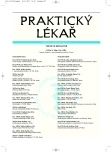Typical and atypical forms of Celiac disease in adults
Typické a atypické formy celiakie u dospělých
Gliadinová frakce obilného lepku vede u celiakie k autoimunitnímu poškození anatomie a funkce sliznice tenkého střeva, současně vede k tvorbě v krvi prokazatelných protilátek proti transglutamináze a gliadinu. Prevalence celiakie je velmi vysoká (1 : 100). Nepoznání choroby, a to je u 7/8 nemocných, vede k poškození zdraví a k zhoubným nádorům, zejména lymfomům. Eliminace lepku ve stravě vede i bez farmakologické intervence k normalizaci nálezů. Srovnání diagnostických nákladů a z toho vyplývající terapie činí z celiakie nejefektivněji léčitelnou diagnózu vnitřního lékařství. V článku je popsán atypický případ celiakie u mladého muže.
Klíčová slova:
celiakie, celiakální sprue, lepek, malabsorpční syndrom.
Authors:
R. Štěpánek; P. Štěpánek-Firkal
Authors‘ workplace:
Soukromá praxe praktického lékaře a internisty, Divišov
Published in:
Prakt. Lék. 2007; 87(12): 739-740
Category:
Case Report
Overview
The gliadin fraction of wheat gluten leads, in celiac disease, to autoimmune damage of the anatomy and function of the mucous membrane of the small intestine; at the same time it leads to the production of blood-detectable antibodies against transglutaminase and gliadin. The prevalence of celiac disease is very high /1 : 100/. Non-identification of the disease, which occurs in 7 out of 8 cases, leads to impaired health and to malignant tumours, particularly lymphomas. Elimination of gluten from the diet results in normalization of the pathological findings without pharmacological intervention. The comparison of diagnostic expense and the consequent treatment makes celiac disease the most effectively treatable diagnosis in internal medicine. In the article, an atypical case of celiac disease in a young male is described.
Key words:
celiac disease, celiac sprue, gluten, malabsorption syndrome.
Labels
General practitioner for children and adolescents General practitioner for adultsArticle was published in
General Practitioner

2007 Issue 12
- Metamizole at a Glance and in Practice – Effective Non-Opioid Analgesic for All Ages
- Memantine in Dementia Therapy – Current Findings and Possible Future Applications
- Advances in the Treatment of Myasthenia Gravis on the Horizon
- Possibilities of Using Metamizole in the Treatment of Acute Primary Headaches
- Hope Awakens with Early Diagnosis of Parkinson's Disease Based on Skin Odor
Most read in this issue
- Functional systems of the human brain
- Laparoscopic cholecystectomy for cholecystolithiasis and its complications. Retrospective 1-year analysis of 411 patients
- Intestinal tapeworms. Do they still exist? Are they still able to surprise us?
- Typical and atypical forms of Celiac disease in adults
